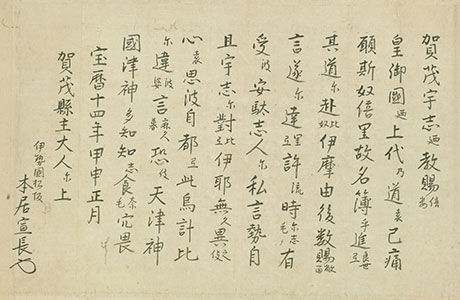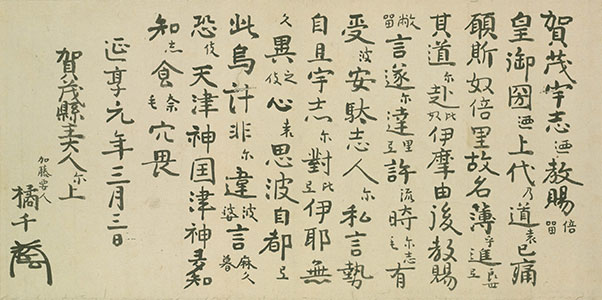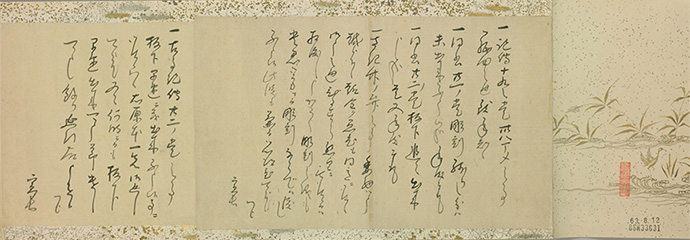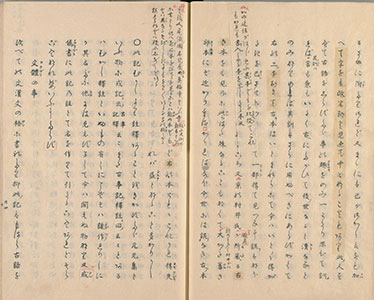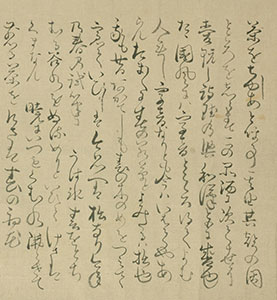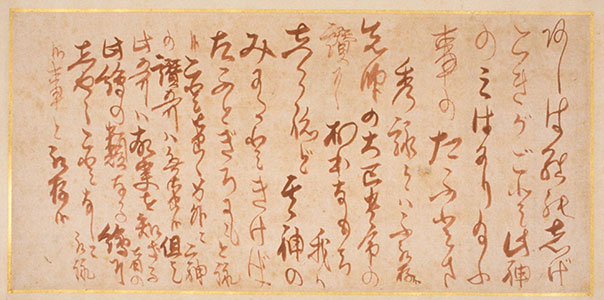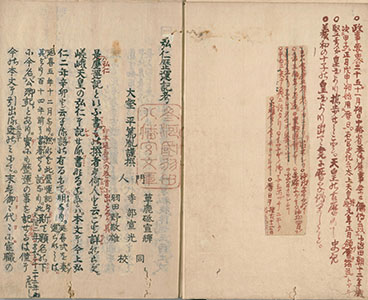Chapter 2: Regarding literary works Scholars of Japanese classical literature
Scholars of Japanese classical literature
MOTOORI Norinaga, 1730-1801
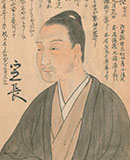 Motoori Norinaga was a scholar of Japanese classical literature from the late Edo period. After studying Genji Monogatari (Tale of Genji), he became a pupil of Kamo Mabuchi in 1764. In addition to his most well-known work titled Kojikiden (lit. Commentaries of the Kojiki), which took him over 30 years of study, Norinaga had written numerous works in various fields, including literary theories as well as studies on Japanese mythological tales and Shinto.
Motoori Norinaga was a scholar of Japanese classical literature from the late Edo period. After studying Genji Monogatari (Tale of Genji), he became a pupil of Kamo Mabuchi in 1764. In addition to his most well-known work titled Kojikiden (lit. Commentaries of the Kojiki), which took him over 30 years of study, Norinaga had written numerous works in various fields, including literary theories as well as studies on Japanese mythological tales and Shinto.
14 Motoori Norinaga seishi (from Ukeigoto, vol. 2), January, 1764[WA18-25]
This is the written oath submitted to Kamo Mabuchi by Norinaga upon his admittance to Mabuchi’s tutelage.
Ukeigoto contains written oaths of 27 pupils. In principle, they had written the exact same words and used the highest quality paper, but Norinaga partially used normal quality paper.
Though the submission of a written oath upon entering school was a typical custom, words of the oaths differed according to the teachers. Comparing this with Kimura Kenkado ’s seimeijo (Related material 24, Chapter 3. “Eyes of science”) is highly recommended.
14 Related material: Tachibana Chikage seishi (from Ukeigoto, vol. 1), March 3, 1744[WA18-25]
This is the written oath submitted by Tachibana (a.k.a. Kato) Chikage upon entering his apprenticeship to Kamo Mabuchi. Though the brushstroke differs from that of Motoori Norinaga, the words written are almost identical.
15 Motoori Norinaga shokan (from Motoori sensei shokan), (left) [February, 1798], (right) [June, 1799][WA25-95]
The series of letter sent from Norinaga, addressed to one of his apprentices, Uematsu Arinobu, who was an engraver for woodcut printing. In these particular articles, Norinaga discusses the block copies and woodcuts of Kojikiden, which he had commissioned Arinobu to make. These are the two letters contained in the beginning of Motoori sensei shokan.
15 Related material: Kojikiden (Norinaga's own handwriting), [1785-1788][WA18-9]
The manuscript of Kojikiden (corresponding to vol. 1) in the possession of the National Diet Library. It is considered to be the final draft. Though the insertions are in Norinaga’s handwriting, the text of the manuscript seems to be written by someone else.
UEDA Akinari, 1734-1809
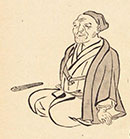 Ueda Akinari is known both as a Japanese classical scholar and as the author of Ugetsu Monogatari from the late Edo period. He was also famous for his talent as a haiku and tanka poet. Though Akinari had a reputation of being an obstinate person for having a dispute with Motoori Norinaga and disparaging Kimura Kenkado, he stayed on good terms with Ota Nampo.
Ueda Akinari is known both as a Japanese classical scholar and as the author of Ugetsu Monogatari from the late Edo period. He was also famous for his talent as a haiku and tanka poet. Though Akinari had a reputation of being an obstinate person for having a dispute with Motoori Norinaga and disparaging Kimura Kenkado, he stayed on good terms with Ota Nampo.
16 Chasetsu, [ca. 1808][WA18-13]
A small essay Akinari had written on tea-themed waka poetry.
Akinari pointed out that although on-yomi (pronunciation of Chinese characters based on Chinese sound) were seldom used in waka, cha (tea) can be an exception.
HIRATA Atsutane, 1776-1843
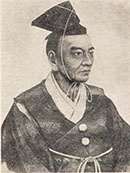 Hirata Atsutane was a scholar of Japanese classical literature who proclaimed to be the ‘posthumous apprentice of Motoori Norinaga’, became his successor in the aspect of ancient ethics study, and advocated the philosophy of reverence for the Emperor’s restoration. Atsutane’s thought had a significant impact on the sonno joi undo (lit. the movement to revere the Emperor and expel the barbarians) at the end of the Edo period.
Hirata Atsutane was a scholar of Japanese classical literature who proclaimed to be the ‘posthumous apprentice of Motoori Norinaga’, became his successor in the aspect of ancient ethics study, and advocated the philosophy of reverence for the Emperor’s restoration. Atsutane’s thought had a significant impact on the sonno joi undo (lit. the movement to revere the Emperor and expel the barbarians) at the end of the Edo period.
17 Hirata Atsutane shukan, [ca. 1830][WA25-12]
This is a letter sent from Atsutane to a Japanese scholar Yashiro Hirokata, answering the questions Yashiro had asked about the meaning of some waka poetry.
This letter was written in reddish brown ink. It is said that this happened because when the messenger from Yashiro came in, Atsutane was in the middle of writing something in that color, and he wrote the reply instantly without switching his brush.
17 Related material: Konin rekiunki ko (Atsutane's own handwriting), [1836][WA18-27]
A draft of a commentary for Konin rekiunki by Atsutane. The use of reddish brown ink can be seen on the right page. ![]()



